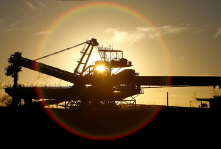
Typical street scene in Santa Ana, El Salvador. (Photo: iStock)
IMF Survey: Mining Boom Bodes Bright Future for Australia
October 28, 2010
- Australia’s GDP growth projected to be 3–3 ½ percent in 2010, 2011
- Managing mining boom set to be major challenge
- Use of fiscal policy, tax reforms, reserves to avoid overheating
Australia has weathered the global financial crisis far better than many other developed economies, thanks to strong demand from emerging Asia and decisive policy responses, but the country now needs to manage a predicted mining boom to prevent the economy from overheating, the IMF warns in its annual report on the state of the Australian economy.

Loading coal in Australia. Mining is fueling Australian growth, but the IMF warns of the need to manage the boom (photo: Mick Tsikas/Corbis/Reuters)
ECONOMIC HEALTH CHECK
Unlike many other advanced economies, Australia managed to escape recession following the global downturn, and GDP growth is projected to be 3–3 ½ percent this year and the next.
The country’s recovery is being driven by a mining boom, with private investment in mining and commodity exports taking over from public demand as the main driver of growth.
“We expect the terms of trade to rise to historic highs in late 2010, driving a mining boom that is likely to be long lasting and could permanently raise household incomes,” said Ray Brooks, the IMF’s mission chief for Australia.
“The positive challenge for Australia is now to manage that boom while avoiding inflationary pressures,” he added.
Managing the boom
The country is benefiting from rebounding commodity prices in its key exports, such as iron ore and coal, with China and India predicted to continue fueling strong demand in the future.
Faster-than-expected growth in Asia could quickly place significant capacity pressure on the Australian economy. “Although the exchange rate would adjust and monetary policy react, allowing the automatic stabilizers to operate fully would avoid potential overheating,” say the economists in their report.
They also recommend saving revenue windfalls, which would build a buffer against any sharp fall in commodity prices and permit those automatic stabilizers to operate during downturns.
The economists also welcomed the planned introduction of a mineral resource rent tax as “a step in the right direction.” Tax reform could play a key role in allowing Australia to reallocate resources to the mining sector, and to take full advantage of the mining boom. They recommend that the new minerals tax could be broadened to cover other mineral resources beyond iron ore and coal.
Supporting recovery
Australian authorities acknowledge that the boost from mining is likely to test the economy’s capacity. Against the background of the country’s strong recovery, the authorities have already started to withdraw policy stimulus. The central bank has raised the policy rate to 4 ½ percent, most recently in May, and the authorities plan to return Commonwealth government budget to surplus by 2012/13.
“If the recovery remains on track and downside risks dissipate, monetary policy will need to tighten further to contain inflation pressures,” said the report.
Australia’s flexible exchange rate also helped the country manage the effects of the crisis and, since the recovery, the value of the Australian currency has been steadily rising against a basket of currencies. The report suggests that the exchange rate is “mildly overvalued”.
However “the extent of the overvaluation is uncertain and is likely to dissipate as interest rates in the United States and other advanced economies eventually normalize,” adds the report.
External risks
The major risks to the Australian economy now come from a possible stalling of the global recovery, or declining Chinese demand for commodities which could result in Australia’s terms of trade falling sharply.
In addition, concerns about fiscal sustainability in Europe could disrupt global financial markets and push up the cost of capital for Australian borrowers.
Australia holds relatively high net external liabilities and sizable short-term external debt, with a projected widening of the current account deficit. IMF economists predict its external liabilities will increase to about 64 percent of GDP in 2015.
Any disruption in global capital markets could put significant pressure on Australian banks because of their short-term offshore funding.
However, the report points out that a number of factors mitigate the vulnerabilities including the size of the gross external debt and the short-term debt, which are smaller than in many other advanced economies.
The country’s banks also engage in extensive currency hedging. The flexible exchange rate would also provide an important buffer in the event of any disruption in global funding markets.


